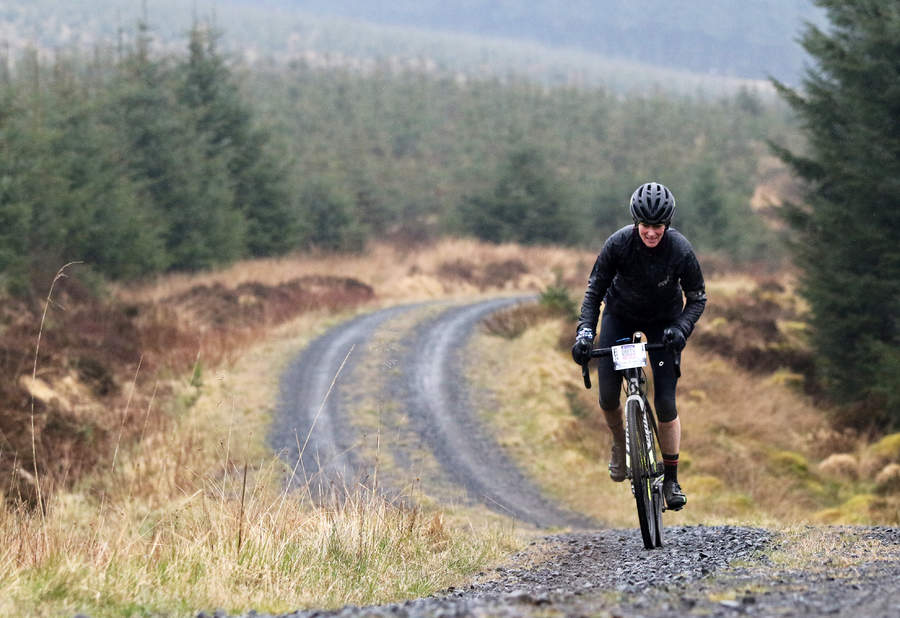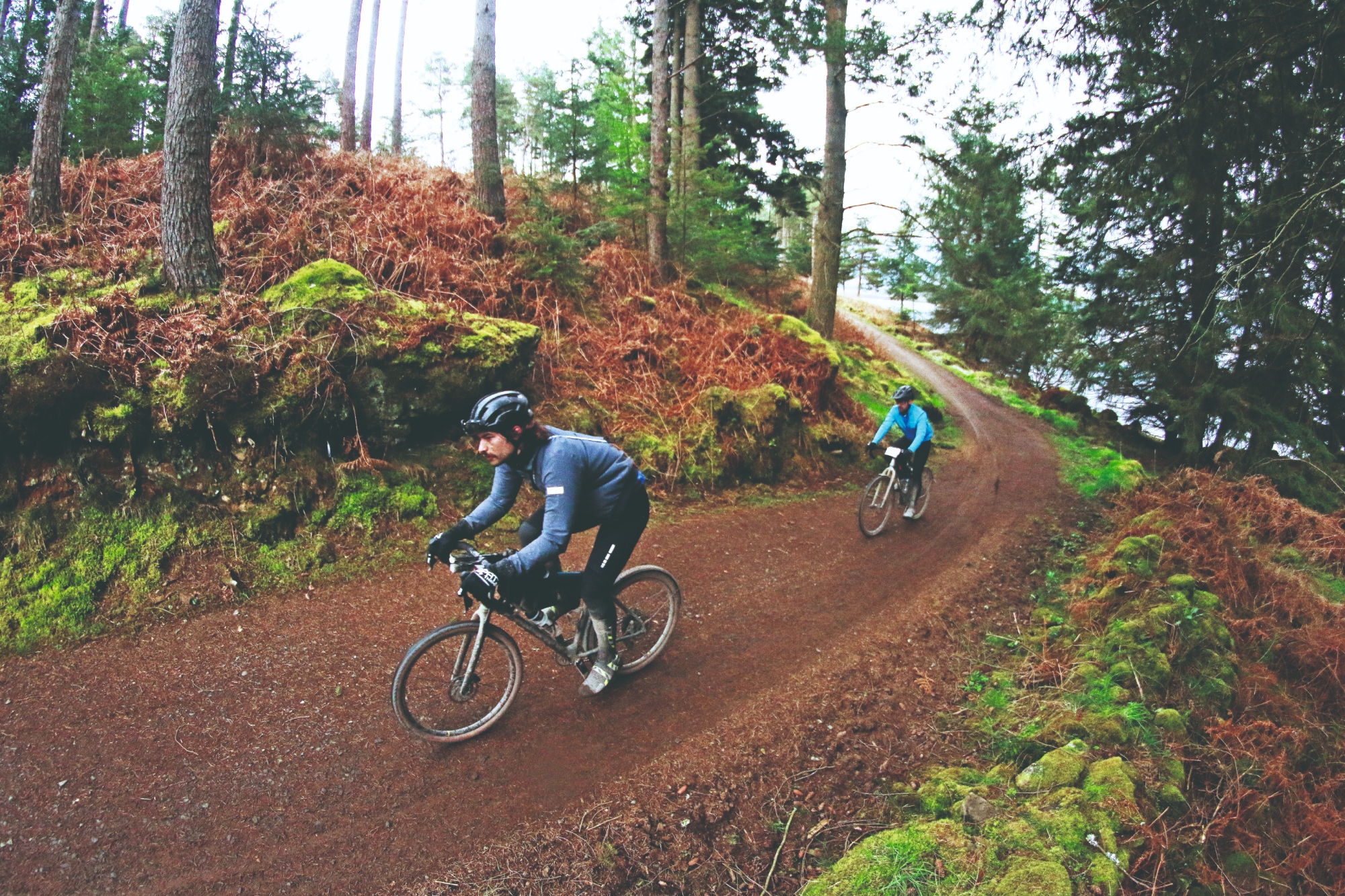7 tips to nail your first gravel event
When you make your gravel riding debut at one of the UK's biggest events you learn a lot


Stealing a glance down at my shoes halfway round the Dirty One-Thirty, I marvelled at just how lavishly they – and the bike – had been painted. A new pale-grey colourway had apparently permeated every crease, fold and machined surface of, well, everything. I could only imagine what my beard, scruffy at the best of times, now looked like.
It was a stark contrast to the early kilometres of the ride, during which the pack of riders I was part of was enveloped by a cloud of dust that was doing a worryingly good job of coating the insides of mouths and noses. All the same, it looked like a scene from some iconic race like Unbound Gravel in the US Midwest rather than North East England.
My ride, the Dirty One-Thirty, is the 123km mid-distance version of the Dirty Reiver – one of the UK’s biggest gravel events and 200km long. Held in Kielder Forest in Northumberland, on the edge of the Scottish border, the ride skirts the huge Kielder Water reservoir and continues south in a big, ragged loop through the forest. There is almost no tarmac, with riders instead being treated to smooth forest tracks – the sort of gravel riding that most of Britain’s curly-barred off-roadies go to sleep dreaming about.
Despite the excellent surfaces, a light but insistent rain that set in around the third-way mark meant riders’ skills met with an extra test as the course slowly became coated in a slick, thin mud. The bright colours of the start pen slowly became ever more muted as wheels flung the stuff over gravel bikes and riders, with a veil of mist adding to the atmosphere on the peaks of some of the highest climbs. ‘Epic’ is a word used way too often, but thanks to the weather, the distance and the terrain, anyone who rode this year’s Dirty Reiver can brandish it with impunity.

Kielder Water marks the start and end of an epic loop
Dirty Reiver is a challenge ride rather than a race. It takes place just across the border from May's Gralloch UCI gravel race, and Raiders Gravel in August. The big scenery and near-perfect tracks common to these areas mean it’s no accident that they are among a number of gravel events that take place in this part of the world. It’s a long drive if you hail from the south of the UK, as we found out. But thankfully if you fancy trying your hand at a big-name gravel bash, you can find them dotted around Britain and perhaps nearer than you think, from Wales to Suffolk to the South Downs in the far south.
These major gravel events are the pinnacle of what is still a fledgling sport in the UK. Most UK riders must hone their fitness on muddy bridleways and crowded towpaths or minor lanes. But the endless gravel doubletrack and major climbs and descents of Britain’s high profile gravel events are the big stage for the country’s riders. It’s also a chance to ride in a large group of like-minded riders in a friendly atmosphere and with some big-event infrastructure to help things along.
Of course, days out like this don’t come for free – whether in terms of on-bike prep, off-bike logistics or financial outlay. Entry for the Dirty Reiver for example is a fairly typical £75, with even the ‘baby’ 65km version coming in at £60. Event fees more generally are used to cover timing systems, insurance, access and location fees, staff and, of course, profit margin. It all mounts up.
The latest race content, interviews, features, reviews and expert buying guides, direct to your inbox!

A gravel face pack comes free to all entrants
Essential Gravel Event Advice
Get your entry in early
If you stumble across one of these major events a month out from the big day you’ll almost certainly find them sold out. Booking early often secures you a favourable early-bird price too.
Structure your training for the demands of the event
Granted, gravel riding for many riders is a lot more about the good old-fashioned notion of enjoying the ride rather than following a strict training regime. But all the enjoyment in the world won’t get you around a ride like the full fat Dirty Reiver without at least the odd foray past the edge of your comfort zone on the bike beforehand. A good rule of thumb for a big distance event like the Dirty Reiver is to ensure you’ve got a couple of rides of at least 75-80% of event distance under your belt in the six weeks beforehand. Event-day determination should see you through the rest.
Have a look at the climbing involved
The Dirty Reiver is listed as having 3,100m of ascent – that’s a lot of climbing, so those long training rides are going to need to be hilly. Glass-cranking round the flattest route you can find isn’t going to cut it at this point. If hills are a rarity where you live, all is not lost. You can climb on the indoor trainer and tackle some big climbs on Zwift, Wahoo and similar, and if you can find even a single small hill near where you are, you can use it for hill-rep sessions in the lead-up to the ride. Of course, this is just a back-of-a-beer-coaster approach. If putting in the best performance you’re capable of on the day is what matters, then enlisting the services of a British Cycling-qualified coach is likely to give you the best chance of that.
Research your accommodation
Once again, timeliness is key – get it booked. In an event with competitor numbers stretching into four figures, B&Bs quickly get booked up. For the Dirty Reiver we were a bit late to the table and ended up staying in a caravan at the end of a private garden. It was charming and well fitted out, but it was also 30 miles away from the event on small roads. Had we booked earlier we could have had an extra hour in bed. Major gravel events, the Dirty Reiver included, often have camping attached, which makes for an excellent budget option that means you are pretty much on the start line as soon as you step out of your tent or camper. Of course, there’s the weather to consider and the fact that tents are not exactly synonymous with a good night’s sleep.
Plan your nutrition in advance
Pre-ride breakfast in particular. You don’t want to be forced to rely on a coffee-shop croissant when you’re staring down the barrel of eight hours of riding. Two-thirds of our group (including yours truly) completely neglected to even think about this element and were forced to forage in the cupboards. One of us, on the other hand, came fully equipped with the breakfast of gravel kings – regulation porridge included – and probably had a better day on the bike for it.

The Reiver’s a remote ride so take the right tools for the job
Make a bike and equipment checklist
The Dirty Reiver was explicit about what items needed to be carried, including an emergency whistle, a survival blanket and a spare thermal top. The chances of needing such items might seem slim, but their inclusion is warranted. Rides like the Dirty Reiver take participants deep into some of Britain’s most sparsely populated terrain. If you break your bike (or even a bone), walking to the next village or flagging down a passing motorist won’t be an option. My survival blanket did indeed get used in anger when I was waiting for my companions to return from their big ride. Of course, I could have been sensible andensured I had a change of clothes waiting at the finish but that would have been too easy, right?
Food for the whole ride was another essential on the Reiver list. It sounds fairly obvious but it can be easy to place all faith in feed stops. There were three of these on the 200km Dirty Reiver and they were well stocked. But most of us have had the experience of arriving at a feed station to find all the good stuff swiped, or perhaps hitting the wall between them, or even getting lost. On the Reiver, the stops were 50km of very hard riding apart – plenty of time for the bonk to make an unwelcome appearance.
Spares and tools could be the difference between finishing or failure
On a major wilderness gravel event you are indulging in fire-play of the highest order if you skimp on these. I had one spare tube, a pack of stick-on patches that I didn’t really trust, plus pump and levers. I had no flats, but I consider it a major let-off that I wasn’t stranded by the side of the trail tearfully pleading to the puncture fairy for mercy. During the event I passed a miserable-looking rider marooned by the trail, wrestling with a muddy tyre and tube in the rain, about once every five to 10 minutes. Next time I’d take three tubes and a repair kit.
Snapped chains were also in abundance, so a spare link and chain tool are essential. If you fail to bring these items and you snap a chain, you’ll want to use it for self-flagellation as punishment for being such an incredible dufus.
With training, accommodation and kit all taken care of, all that remains is for you to have an incredible day riding some of the best gravel trails the country has to offer. Soak up the scenery, revel in the wilderness and enjoy the friendly company (and it will be friendly). Oh, and don’t forget your waterproof.
Dirty Reiver Information

Where is the race held?
Kielder Forest, Northumberland, England
Race distances
200KM / 123KM / 65KM
When is the 2024 Dirty Reiver?
Dates have yet to be announced but entries open on the Dirty Reiver website on December 1
How to get there
Kielder is around 30 miles from the nearest railway station, so driving is the order of the day, unless you’re hardcore enough to add 60 miles’ riding to your trip (chapeau!). From either the north or south, a motorway will get you to either Carlisle or Newcastle, from where it’s a 40-50 mile drive on A and B-roads.
Where to stay
The event features camping or space for camper vans. Kielder itself is very small, with little accommodation, but there is plenty in the wider area. We stayed in the town of Hexham, around a 45-minute drive south of the event HQ.
Bike shops
There are three bike shops at Hexham, but that’s 30 miles from the event. With plenty of brands showcasing their kit, you may find what you need at the event HQ at Kielder Castle. Better still, ensure your bike is well MOT’d and bring all the spares you might need and more.
Which bike should I ride?
The majority of riders were using gravel bikes at the Reiver, but plenty were using hardtail mountain bikes, and even full-suspension e-bikes for the 65km Dirty E-Reiver. The event recommends a minimum 33mm gravel tyre but in the inclement conditions we experienced, 38mm might have been a better option.
After cutting his teeth on local and national newspapers, James began at Cycling Weekly as a sub-editor in 2000 when the current office was literally all fields.
Eventually becoming chief sub-editor, in 2016 he switched to the job of full-time writer, and covers news, racing and features.
He has worked at a variety of races, from the Classics to the Giro d'Italia – and this year will be his seventh Tour de France.
A lifelong cyclist and cycling fan, James's racing days (and most of his fitness) are now behind him. But he still rides regularly, both on the road and on the gravelly stuff.
